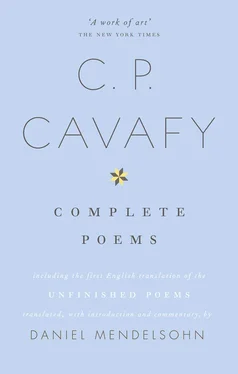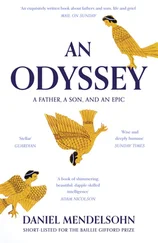1 ...7 8 9 11 12 13 ...27 The 1928 poem “Days of 1909, ’10, and ’11” treats a favorite theme: the squalid life of an impoverished young man whose spectacular beauty stands in stark contrast to his humble circumstances—and, in this case, to his convenient morals. (We’re told that the lovely blacksmith’s assistant is willing to sell his favors, if necessary, in order to buy a coveted tie or expensive shirt.) In the poem’s final stanza, the narrator wonders whether even ancient Alexandria, famed for its louche and comely youths, could claim a young man as lovely as this down-at-the-heels boy. Here, the contrast between the allure of the youths in the glittering ancient city and that of a common blacksmith’s boy is suggestively conveyed by the shift in tone between the adjective used of the former, perikallis, and the noun used of the latter, agori: for the former is a high-flown katharevousa word taken directly from the Ancient Greek (which I translate by means of the rather stiff “beauteous”), while the latter is a noun as worn and plain as a pebble: “lad.”
Even more strikingly, in “The Seleucid’s Displeasure,” first written in 1910 and published in 1916, a large part of the meaning of the entire poem rests on the difference between a katharevousa and a demotic word, both of which mean the same thing. Set in the second century B.C., as the Hellenistic monarchies founded after the death of Alexander were crumbling before an emergent Rome, the poem treats the painful disappointment felt by one Greek monarch, Demetrius I Soter of the Seleucid house in Asia, on hearing that his Egyptian counterpart, Ptolemy VI, had cast aside his royal dignity and traveled to Rome as a supplicant in order to appeal for help in a dynastic struggle against his brother. The first two stanzas evoke Demetrius’s grandiose regard for the dignity “befitting … an Alexandrian Greek monarch”: to the impoverished Ptolemy he offers lavish clothing, jewels, and a retinue for his presentation to the Senate.
The Seleucid monarch’s attitude is pointedly contrasted with Ptolemy’s canny appreciation for political realities; he knows that he’s likelier to obtain Roman aid if he appears humble when he makes his appeal. His abject willingness to come down off his royal pedestal is brilliantly evoked in the Greek. In the first line of the stanza he is described as having come for the purposes of epaiteia, a noun with roots in Classical and Byzantine Greek that means everything from “a request” to “begging”; but in the last line, the verb used for the reason for his visit is the demotic zondanevo, “to beg.” Hence the shift from the high to the demotic forms, both words meaning the same thing, itself beautifully reflects the demotion in his status from an ostensibly independent ruler to a supplicant reliant on the power of others. In my rendering of these lines, I have attempted to suggest this tonal shift by using an abstruse term in the first instance, and a familiar, monosyllabic word in the second:
But the Lagid, who had come a mendicant,
knew his business and refused it all:
He didn’t need these luxuries at all.
Dressed in worn old clothes, he humbly entered Rome,
and found lodgings with a minor craftsman.
And then he presented himself to the Senate
as an ill-fortuned and impoverished man,
that with greater success he might beg.
As these two examples indicate, I have tried to convey distinctions between katharevousa and demotic, when possible, by using high Latinate forms in the case of the former, and ordinary, plain Anglo-Saxon derivations in the case of the latter—an imperfect, but I hope suggestive, means of conveying this vital aspect of Cavafy’s technique. In certain cases, moreover (“Philhellene,” for one), I have used British spellings when rendering katharevousa, since these—as indeed with the archaic spellings of certain words that Cavafy often favored—instantly and quite effectively (to the American eye) signal a different, often elite cultural milieu, which is part of katharevousa’s flavor.
There are other stylistic matters, resulting in other choices I have made, with which the reader should be acquainted. However much Cavafy’s language may eschew the devices—metaphor, simile, figurative and “lyrical” language—that we normally associate with poetry, his verse, in Greek, is unmistakably musical. This music results principally from two stylistic features, which I have taken pains, whenever possible, to reproduce.
The first is meter. Very often Cavafy’s lines have a strong iambic rhythm; very often, too, he favors a five-beat line that English speakers are familiar with—as Cavafy himself was, from his deep reading of British poets. (There is, indeed, a distinctly English cast to many of his poems, as commentators have observed.) Although he will often preserve a strict iambic pentameter, he just as often loosens the line when it suits his purposes. In “Nero’s Deadline,” for instance, we first learn about the Delphic oracle’s warning (that the emperor should “beware the age of seventy-three”), as the direct object of the verb “heard,” in a line with a strictly iambic beat with precisely ten syllables (I have marked the stresses with acute accents):
tou Dhélfikoú mantíou tón khrismó
the prophecy of the Delphic Oracle
Here, the preciseness of the meter vividly suggests the ineluctable character of the oracle itself. By contrast, the first line of the second stanza, in which the poet describes how Nero returns to Rome from a pleasure trip to Athens exhausted by his sensual indulgences, Cavafy maintains a five-beat line while padding it with five extra syllables:
Tóra stin Rhómi tha epitrépsei kourasménos lígo
Now to Rome he’ll be returning a little bit wearied
The subtle loosening of the line nicely conveys the relaxation of the self-involved Nero, who is blithely unaware that his days of aesthetic and erotic pleasure are numbered.
These strong and suggestive rhythms structure much of the verse, from the early sonnets of the 1890s to the poems of his last decade; without them, the poetry, already devoid of the usual devices, might well seem flat-footed in a way that indeed reminds us that both the Ancient and the Modern Greek word for prose, pezos, literally means “pedestrian”—that is, language that lumbers along arhythmically instead of dancing. Fortunately for the English translator, English itself falls quite naturally into the rhythms that Cavafy favored.
Cavafy is, indeed, endlessly inventive with his meters. In certain early lyrics, for example “La Jeunesse Blanche” (1895) and “Chaldean Image” (1896), the very elaborate metrical schemes betray the young poet’s infatuation with the Continental poetry of the day; while in others, like the Repudiated Poem “A Love” (1896), we hear the thrumming fifteen-syllable beat characteristic of the Greek popular songs so beloved of this poet. (In a famous 1904 poem, “Waiting for the Barbarians,” Cavafy rather suggestively casts the anxious questions of the speakers in this “Greek” rhythm, while the answers that come back are in “English” iambics.) One particularly noteworthy metrical innovation can be observed in a number of lyrics composed in what George Seferis, in commenting on these poems, referred to as a “tango” rhythm. Each line of these poems is composed of two half lines of three beats each; the lines are separated by white space. Hence, for instance, the opening of “In Despair” looks like this:
| Ton ékhas’ éndhelós. |
Ke tóra piá zití |
| sta khíli káthenós |
kenoúriou érastí |
| ta khíli tá diká tou … |
| He’s lost him utterly. |
And from now on he seeks |
| in the lips of every new |
lover that he takes |
| the lips of that one: his. |
These tango poems, in striking contrast to their ostensibly jaunty meter (which, however, also savors slightly of the Orthodox liturgy), are more often than not about devastating disappointment or frustrated desire: for instance, “In the Taverns,” in which a rejected lover consoles himself by “wallowing” in the demimonde of Beirut; “Temethus, an Antiochene: 400 A.D.,” in which the verses of a poet “suffering in love” are “heated” because the historical figure he writes about is merely a stand-in for his lover; or “On the Italian Seashore,” a historical poem in which an Italian youth of Greek descent stands “pensive and dejected” as he watches Roman troops unload the booty from their conquest of Greece in 146 B.C. Because this rhythm has such great technical and thematic significance, it seemed to me worthwhile to attempt to reproduce it, where possible.
Читать дальше












